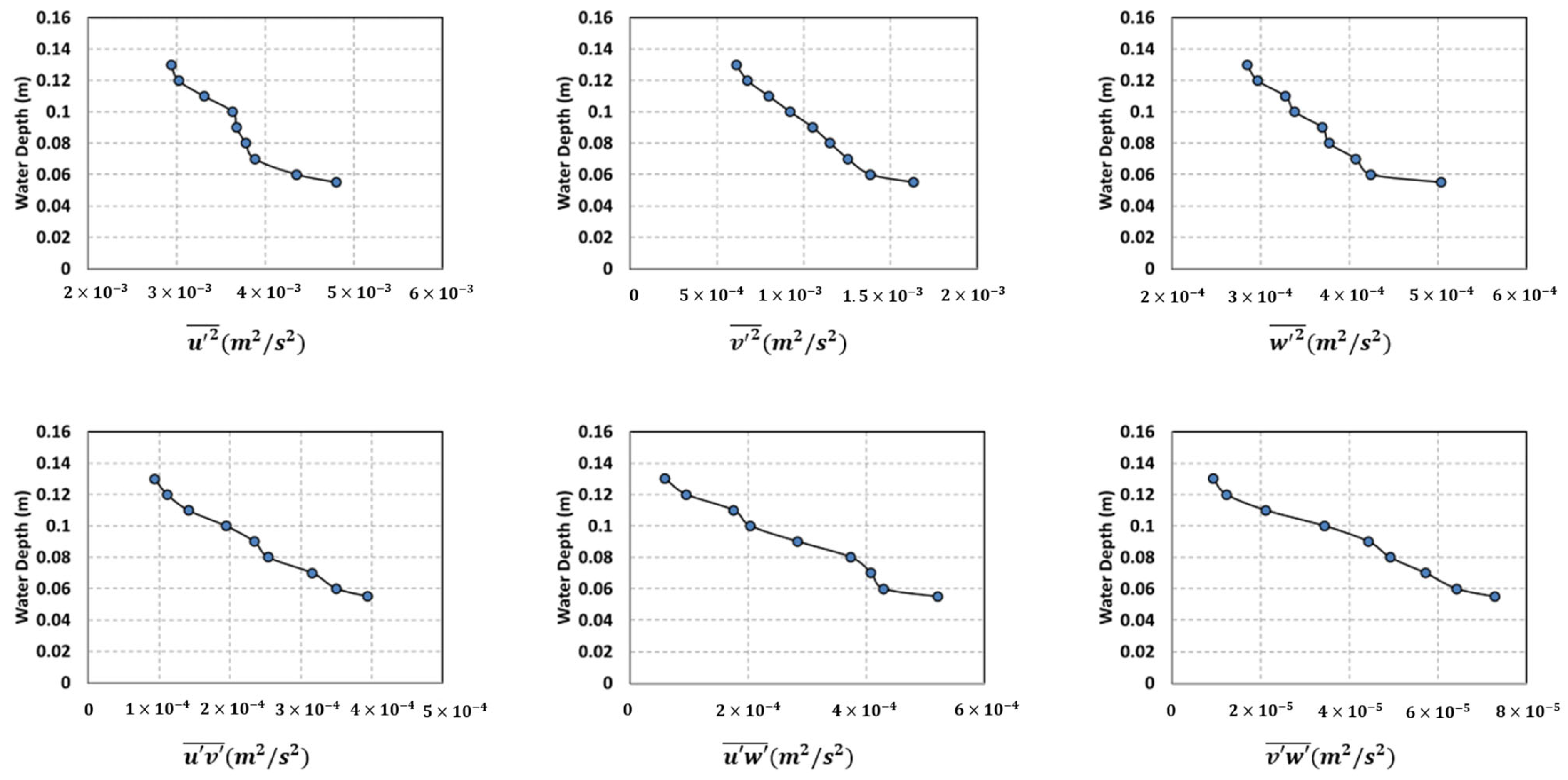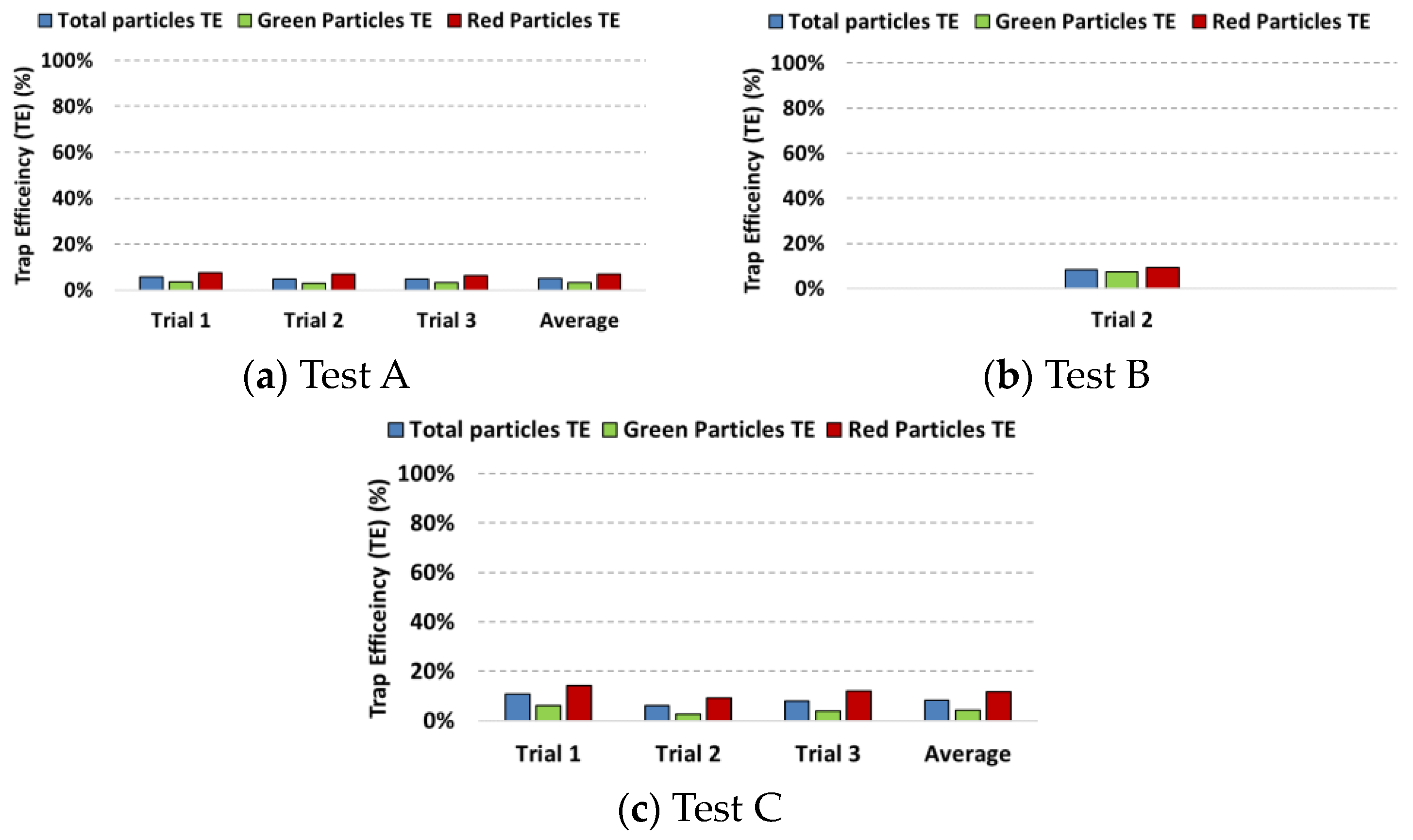A Laboratory Dataset on Transport and Deposition of Spherical and Cylindrical Large Microplastics for Validation of Numerical Models
Abstract
1. Introduction
2. Experimental Setup
Experimental Cases
3. Results
3.1. Settling Velocity of Spherical and Cylindrical Microplastics
3.2. Case 1—Spherical MP Deposition in Channel with a Low Velocity of Flow
3.3. Case 2—Spherical MP Deposition in Channel with a High Velocity of Flow
3.4. Case 3—Cylindrical MP Deposition in Channel with a Low Velocity of Flow
3.5. Case 4—Cylindrical MP Deposition in Channel with a High Velocity of Flow
4. Discussion and Conclusions
Author Contributions
Funding
Institutional Review Board Statement
Informed Consent Statement
Data Availability Statement
Conflicts of Interest
Appendix A



References
- Corcoran, L.; Belontz, S.L.; Ryan, K.; Walzak, M.J. Factors controlling the distribution of microplastic particles in benthic sediment of the Thames River, Canada. Environ. Sci. Technol. 2019, 54, 818–825. [Google Scholar] [CrossRef] [PubMed]
- Hartmann, N.B.; Skjolding, L.M.; Nolte, T.; Baun, A. Aquatic ecotoxicity testing of nanoplastics-lessons learned from nanoecotoxicology. In SETAC Europe 26th Annual Meeting; SETAC Europe: Brussels, Belgium, 2016; pp. 43–44. [Google Scholar]
- Rocha-Santos, T.; Duarte, A.C. A critical overview of the analytical approaches to the occurrence, the fate and the behavior of microplastics in the environment. TrAC Trends Anal. Chem. 2015, 65, 47–53. [Google Scholar] [CrossRef]
- EU. Environmental and Health Risks of Microplastic Pollution; EU: Maastricht, The Netherlands, 2019. [Google Scholar]
- Barnes, D.K.; Galgani, F.; Thompson, R.C.; Barlaz, M. Accumulation and fragmentation of plastic debris in global environments. Philos. Trans. R. Soc. B Biol. Sci. 2009, 364, 1985–1998. [Google Scholar] [CrossRef] [PubMed]
- Koelmans, A.A.; Bakir, A.; Burton, G.A.; Janssen, C.R. Microplastic as a vector for chemicals in the aquatic environment: Critical review and model-supported reinterpretation of empirical studies. Environ. Sci. Technol. 2016, 50, 3315–3326. [Google Scholar] [CrossRef] [PubMed]
- Carrol, C.; Sousa, J.; Thevenon, F. Plastic Debris in the Ocean: The Characterization of Marine Plastics and Their Environmental Impacts, Situation Analysis Report; International Union for Conservation of Nature (IUCN): Gland, Switzerland, 2014; Volume 52, pp. 549–562. [Google Scholar]
- Napper, I.E.; Thompson, R.C. Marine plastic pollution: Other than microplastic. In Waste; Academic Press: Cambridge, MA, USA, 2019; pp. 425–442. [Google Scholar]
- Wright, S.L.; Kelly, F.J. Plastic and human health: A micro issue? Environ. Sci. Technol. 2017, 51, 6634–6647. [Google Scholar] [CrossRef] [PubMed]
- Khatmullina, L.; Isachenko, I. Settling velocity of microplastic particles of regular shapes. Mar. Pollut. Bull. 2017, 114, 871–880. [Google Scholar] [CrossRef] [PubMed]
- Schwarzer, M.; Brehm, J.; Vollmer, M.; Jasinski, J.; Xu, C.; Zainuddin, S.; Fröhlich, T.; Schott, M.; Greiner, A.; Scheibel, T.; et al. Shape, size, and polymer dependent effects of microplastics on Daphnia magna. J. Hazard. Mater. 2022, 426, 128136. [Google Scholar] [CrossRef]
- Nava, V.; Leoni, B. A critical review of interactions between microplastics, microalgae and aquatic ecosystem function. Water Res. 2021, 188, 116476. [Google Scholar] [CrossRef] [PubMed]
- Liu, P.; Zhan, X.; Wu, X.; Li, J.; Wang, H.; Gao, S. Effect of weathering on environmental behavior of microplastics: Properties, sorption and potential risks. Chemosphere 2020, 242, 125193. [Google Scholar] [CrossRef]
- Miranda, M.N.; Sampaio, M.J.; Tavares, B.; Silva, A.M.; Pereira, M.F.R. Aging assessment of microplastics (LDPE, PET and uPVC) under urban environment stressors. Sci. Total Environ. 2021, 796, 148914. [Google Scholar] [CrossRef]
- De Leo, A.; Cutroneo, L.; Sous, D.; Stocchino, A. Settling velocity of microplastics exposed to wave action. J. Mar. Sci. Eng. 2021, 9, 142. [Google Scholar] [CrossRef]
- Doyle, M.J.; Watson, W.; Bowlin, N.M.; Sheavly, S.B. Plastic particles in coastal pelagic ecosystems of the Northeast Pacific ocean. Mar. Environ. Res. 2011, 71, 41–52. [Google Scholar] [CrossRef] [PubMed]
- Bigdeli, M.; Mohammadian, A.; Pilechi, A.; Taheri, M. Lagrangian modeling of marine microplastics fate and transport: The state of the science. J. Mar. Sci. Eng. 2022, 10, 481. [Google Scholar] [CrossRef]
- Kooi, M.; Nes, E.H.V.; Scheffer, M.; Koelmans, A.A. Ups and downs in the ocean: Effects of biofouling on vertical transport of microplastics. Environ. Sci. Technol. 2017, 51, 7963–7971. [Google Scholar] [CrossRef]
- Jalón-Rojas, I.; Wang, X.H.; Fredj, E. A 3D numerical model to Track Marine Plastic Debris (TrackMPD): Sensitivity of microplastic trajectories and fates to particle dynamical properties and physical processes. Mar. Pollut. Bull. 2019, 141, 256–272. [Google Scholar] [CrossRef] [PubMed]
- Mason, S.A.; Daily, J.; Aleid, G.; Ricotta, R.; Smith, M.; Donnelly, K.; Knauff, R.; Edwards, W.; Hoffman, M.J. High levels of pelagic plastic pollution within the surface waters of Lakes Erie and Ontario. J. Great Lakes Res. 2020, 46, 277–288. [Google Scholar] [CrossRef]
- Decuzzi, P.; Lee, S.; Bhushan, B.; Ferrari, M. A theoretical model for the margination of particles within blood vessels. Ann. Biomed. Eng. 2005, 33, 179–190. [Google Scholar] [CrossRef]
- Choi, C.E.; Zhang, J.; Liang, Z. Towards realistic predictions of microplastic fiber transport in aquatic environments: Secondary motions. Water Res. 2022, 218, 118476. [Google Scholar] [CrossRef] [PubMed]
- Boos, J.; Gilfedder, B.S.; Frei, S. Tracking microplastics across the streambed interface: Using laser-induced-fluorescence to quantitatively analyze microplastic transport in an experimental flume. Water Resour. Res. 2021, 57, e2021WR031064. [Google Scholar] [CrossRef]
- Pohl, F.; Eggenhuisen, J.T.; Kane, I.A.; Clare, M.A. Transport and burial of microplastics in deep-marine sediments by turbidity currents. Environ. Sci. Technol. 2020, 54, 4180–4189. [Google Scholar] [CrossRef]
- Kerpen, N.B.; Schlurmann, T.; Schendel, A.; Gundlach, J.; Marquard, D.; Hüpgen, M. Wave-induced distribution of microplastic in the surf zone. Front. Mar. Sci. 2020, 7, 590565. [Google Scholar] [CrossRef]
- Waldschläger, K.; Schüttrumpf, H. Effects of particle properties on the settling and rise velocities of microplastics in freshwater under laboratory conditions. Environ. Sci. Technol. 2019, 53, 1958–1966. [Google Scholar] [CrossRef] [PubMed]
- Middleton, G.V. Hydraulic interpretation of sand size distributions. J. Geol. 1976, 84, 405–426. [Google Scholar] [CrossRef]
- Zhiyao, S.; Tingting, W.; Fumin, X.; Ruijie, L. A simple formula for predicting settling velocity of sediment particles. Water Sci. Eng. 2008, 1, 37–43. [Google Scholar] [CrossRef]
- Clift, R.; Gauvin, W. Motion of entrained particles in gas streams. Can. J. Chem. Eng. 1971, 49, 439–448. [Google Scholar] [CrossRef]
- Cheng, N.-S. Comparison of formulas for drag coefficient and settling velocity of spherical particles. Powder Technol. 2009, 189, 395–398. [Google Scholar] [CrossRef]
- Shankar, M.S.; Pandey, M.; Shukla, A.K. Analysis of existing equations for calculating the settling velocity. Water 2021, 13, 1987. [Google Scholar] [CrossRef]









| Case | Flow Velocity (m/s) | Deepening in Depth (cm) | Expansion in Width (cm) | Material | Shape |
|---|---|---|---|---|---|
| Case 1—Spherical MP deposition in channel with a low velocity of flow | Low velocity U = 0.1 m/s | 0 and 7 | 10 and 18 | PET | Spherical |
| Case 2—Spherical MP deposition in channel with a high velocity of flow | High velocity U = 0.5 m/s | 0 and 7 | 10 and 18 | PET | Spherical |
| Case 3—Cylindrical MP deposition in channel with a low velocity of flow | Low velocity U = 0.1 m/s | 0 and 7 | 10 and 18 | PVC | Cylindrical |
| Case 4—Cylindrical MP deposition in channel with a high velocity of flow | High velocity U = 0.5 m/s | 0 and 7 | 10 and 18 | PVC | Cylindrical |
| Case | Test | Flow Velocity (m/s) | Water Surface Elevation (cm) | Channel Depth at Zone B (cm) | Channel Width at Zone B(cm) | Large/Moderate Expansion/Deepening |
|---|---|---|---|---|---|---|
| Case 1 | A | Low velocity U = 0.1 m/s | 19.1 | 0 | 38 | Large expansion |
| B | 19.8 | 7 | 38 | Large expansion and deepening | ||
| C | 19.8 | 7 | 30 | Moderate expansion and large deepening | ||
| Case 2 | A | High velocity U = 0.5 m/s | 35 | 0 | 38 | Large expansion |
| B | 37 | 7 | 38 | Large expansion and deepening | ||
| C | 37 | 7 | 30 | Moderate expansion and large deepening | ||
| Case 3 | A | Low velocity U = 0.1 m/s | 19.1 | 0 | 38 | Large expansion |
| B | 19.8 | 7 | 38 | Large expansion and deepening | ||
| C | 19.8 | 7 | 30 | Moderate expansion and large deepening | ||
| Case 4 | A | High velocity U = 0.5 m/s | 35 | 0 | 38 | Large expansion |
| B | 37 | 7 | 38 | Large expansion and deepening |
Disclaimer/Publisher’s Note: The statements, opinions and data contained in all publications are solely those of the individual author(s) and contributor(s) and not of MDPI and/or the editor(s). MDPI and/or the editor(s) disclaim responsibility for any injury to people or property resulting from any ideas, methods, instructions or products referred to in the content. |
© 2024 by the authors. Licensee MDPI, Basel, Switzerland. This article is an open access article distributed under the terms and conditions of the Creative Commons Attribution (CC BY) license (https://creativecommons.org/licenses/by/4.0/).
Share and Cite
Bigdeli, M.; Mohammadian, A.; Pilechi, A. A Laboratory Dataset on Transport and Deposition of Spherical and Cylindrical Large Microplastics for Validation of Numerical Models. J. Mar. Sci. Eng. 2024, 12, 953. https://doi.org/10.3390/jmse12060953
Bigdeli M, Mohammadian A, Pilechi A. A Laboratory Dataset on Transport and Deposition of Spherical and Cylindrical Large Microplastics for Validation of Numerical Models. Journal of Marine Science and Engineering. 2024; 12(6):953. https://doi.org/10.3390/jmse12060953
Chicago/Turabian StyleBigdeli, Mostafa, Abdolmajid Mohammadian, and Abolghasem Pilechi. 2024. "A Laboratory Dataset on Transport and Deposition of Spherical and Cylindrical Large Microplastics for Validation of Numerical Models" Journal of Marine Science and Engineering 12, no. 6: 953. https://doi.org/10.3390/jmse12060953
APA StyleBigdeli, M., Mohammadian, A., & Pilechi, A. (2024). A Laboratory Dataset on Transport and Deposition of Spherical and Cylindrical Large Microplastics for Validation of Numerical Models. Journal of Marine Science and Engineering, 12(6), 953. https://doi.org/10.3390/jmse12060953







